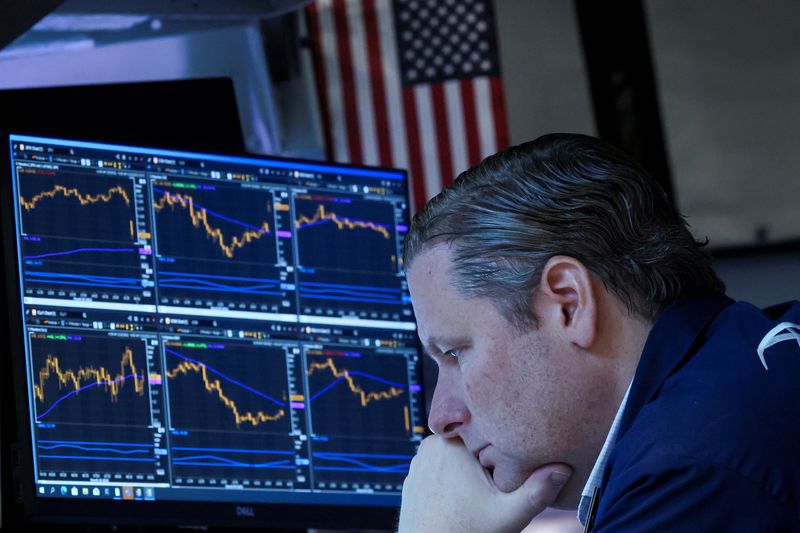Investing.com -- U.S. stock futures advanced on Friday, with markets awaiting the publication of the June nonfarm payrolls report. The figures are expected to show a possible easing in labor demand, which may fuels hopes for Federal Reserve interest rate cuts this year. Elsewhere, Samsung Electronics (LON:0593xq) says it expects to see a 15-fold jump in income in the second quarter thanks to soaring demand for artificial intelligence.
1. Futures higher
U.S. stock futures pointed higher on Friday, as investors looked ahead to the release of a key monthly labor market report (more below).
By 03:27 ET (07:27 GMT), the Dow futures contract had gained 57 points or 0.2%, S&P 500 futures had risen by 7 points or 0.1%, and Nasdaq 100 futures had increased by 41 points or 0.2%.
The main averages on Wall Street were closed for the Independence Day holiday on Thursday.
2. Nonfarm payrolls ahead
U.S. employers are tipped to have added fewer jobs in June, potentially signaling a cooling labor demand that could bolster the case for the Federal Reserve to begin slashing interest rates down from more than two-decade highs later this year.
Economists predict that nonfarm payrolls came in at 191,000 last month, down from 272,000 in May. Meanwhile, the rate of growth in average hourly wages is estimated to have slowed marginally to 0.3% month-on-month and the unemployment rate is seen matching May's pace of 4.0%.
Data earlier this week showed that private payrolls growth eased last month and the quits rate -- a gauge of labor market confidence -- held steady, suggesting possibly waning pressure from wages.
Steam leaving the jobs market could lead to less upward pressure on inflation, a trend that may support hopes that the Fed will cut rates in 2024. The central bank has said it plans to reduce borrowing costs just once this year, as policymakers hunt for more evidence that price gains are sustainably moderating.
3. Samsung Electronics expects surge in second-quarter profit
Samsung Electronics (KS:005930) expects to clock an exponential rise in its second-quarter profit as the technology conglomerate was further boosted by artificial intelligence-driven demand for memory chips and electronic devices.
The world's biggest maker of memory chips said on Friday that its operating profit for the three months to June 30 likely rose to 10.4 trillion won ($7.50 billion), compared to a profit of 670 billion won for the same period last year.
The figure -- the highest since the third quarter of 2022 -- was far above predictions for income of 8.8 trillion won, according LSEG SmartEstimate forecasts cited by Reuters.
Samsung’s better-than-anticipated earnings were powered by increased demand for memory chips from the AI industry, particularly high-bandwith memory chips. Samsung said it will begin mass producing advanced HBM chips from this year, with a view to win more orders from AI-darling Nvidia (NASDAQ:NVDA).
4. Labour landslide; French vote looms
The changing political climate in the U.K. will be at the forefront of investors’ attention Friday, after the opposition Labour Party surged to a comprehensive win in a parliamentary election, ending 14 years of often turbulent Conservative government.
As of 03:16 ET, Labour, led by Keir Starmer, had won 410 of the 650 seats in parliament, giving it a large majority with a handful of seats yet to declare.
U.K. stocks have gained, as has the pound, as traders appear to have judged that a period of intense market volatility, driven by political and economic tumult under the Conservatives, may be drawing to a close.
That said, the election also saw the growth of the right-wing populist Reform UK party, headed by Brexit campaigner Nigel Farage.
This brings the second round of voting in the French parliamentary election, due on Sunday, into focus, after the success of the far-right National Rally in last weekend’s initial vote.
5. Oil steady
Crude prices hovered around the flatline on Friday, but were on track for a fourth consecutive positive week on hopes of strong summer fuel demand in the U.S.
By 03:19 ET, the U.S. crude futures (WTI) were mostly unchanged at $84.05 a barrel, while the Brent contract was broadly steady at $87.45 a barrel.
Oil rose this week on strong summer demand expectations in the U.S., the world's largest oil consumer, with official data from the Energy Information Administration showing that the country's crude and fuel stockpiles all fell by more than projected last week.
Market sentiment has also been underpinned this week by intensifying geopolitical tension in the Middle East.
